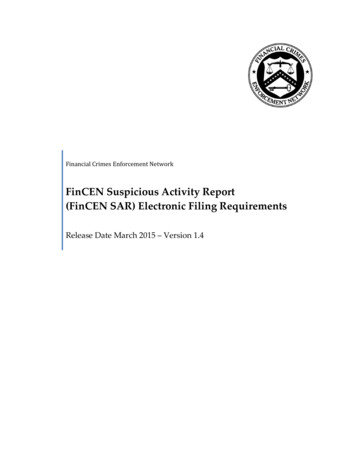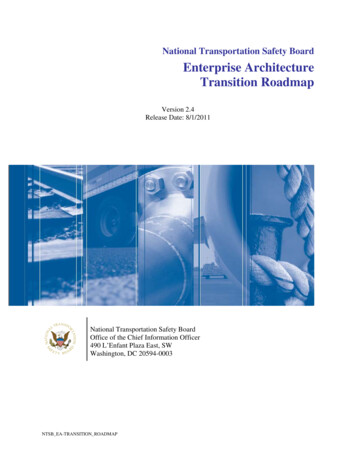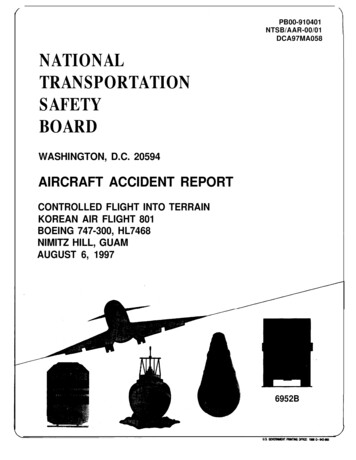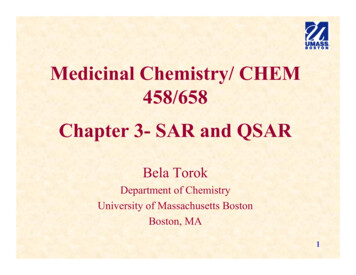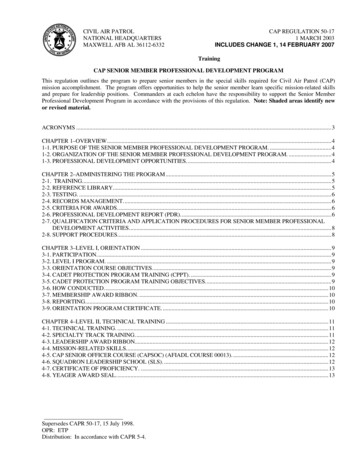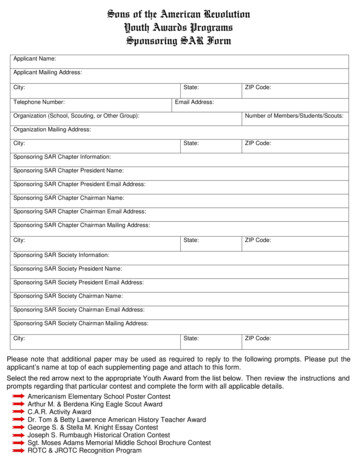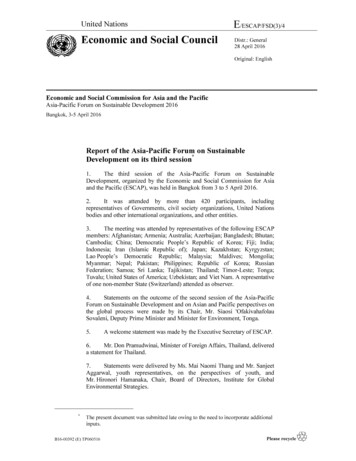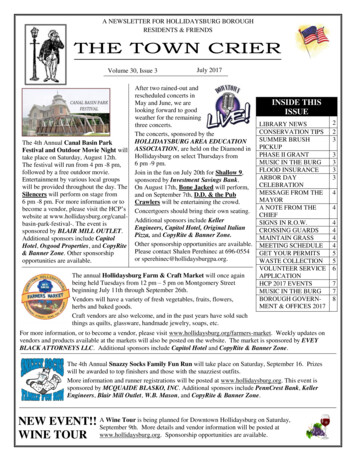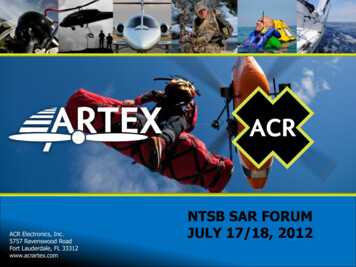
Transcription
ACR Electronics, Inc.5757 Ravenswood RoadFort Lauderdale, FL 33312www.acrartex.comNTSB SAR FORUMJULY 17/18, 2012
Artex & ACR History Artex History––––Founded in 1971 by Bob ChambersPurchased by Chelton Avionics (Cobham) in 1998Moved from Aurora, Oregon to Prescott, Arizona in 2010ACR Electronics, Inc Acquired ELT Product line in December 2011 &moved manufacturing to Fort Lauderdale ACR History– ACR Manufactures Products for Land, Sea, & Air Markets– Wide Array of Users In Recreational, Commercial, Military– Received AS9100 Certification of Quality Management System on April24, 2012 Number of 406MHz Beacons Manufactured by Artex/ACR– Total Exceeds 1.5 M Beacons (EPIRBs 800K, PLBs 400K, ELTs 200K)
Standards Participation Artex participation in Aviation standards bodies– Chairman and Secretary of SC-204 to amend RTCA DO-204 to DO-204a– Participant in European/EASA standard change from ED-62 to ED-62a– Participant in RTCM SC110 subcommittee on 406 MHz Beacons ACR participation in Land/Marine Standard bodies– Chairman of RTCM SC110 (Beacons), SC128 (SENDs), SC119 (VHF DSCHand Held Radios) subcommittees– Participant in RTCM SC119 Maritime Survivor Locator DevicesSubcommittee– Board member of RTCM
Standards Participation Participation in Cospas-Sarsat Activities– Head of RTCM Delegation to Cospas-Sarsat– Represent Beacon Manufacture’s at Cospas-Sarsat Meetings andproviding input papers as appropriate– Attend Joint Council meeting providing input on Beacon Specifications– Attend Experts Working Group Meetings developing Second-GenerationBeacon Specifications International Activities– Expert of IEC TC80 Committee Maritime Navigation and RadioEquipment and Systems– IEC TC 80 Team 2 Leader for 406 MHz EPIRB Standard– Member of UK IEC TC80 Committee providing input GMDSS– Member of UK ITU WP5B committee on input on ITU Aeronautical,maritime and radio location matters.
ELT System Overview Main ELT Components– ELT Transmitter (3 GA, 4 Bus/Com, 4 Rotorcraft ELTs)– Cockpit Remote Switches (12 different Remote Switches)– Antenna and Coax (5 Blade, 3 Rod, 6 Whip Antennas)Single antenna output for emergency transmission on both406 MHz and 121.5 MHz frequenciesOR
ELT CertificationELT Certification– Applicable ELT Technical Standard Order (TSO) TSO C126a, 406 MHz Emergency Locator Transmitter (ELT)– RTCA DO-204a, Minimum Operational Performance Standards for 406MHzEmergency Locator Transmitters (ELT)– RTCA DO-178b, Software Considerations in Airborne Systems andEquipment Certification– RTCA DO-160G, Environmental Conditions and Test Procedures forAirborne Equipment– RTCA DO-254, Design Assurance Guidance for Airborne ElectronicHardware– COSPAS-SARSAT T.001, Specification for Cospas-Sarsat 406 MHz DistressBeacons– COSPAS-SARSAT T.007, Cospas-Sarsat 406MHz Distress Beacon TypeApproval Standard TSO C142, Non-Rechargeable Lithium Cells and Batteries– RTCA DO-227, Minimum Operational Performance Standards for LithiumBatteries
ELT CertificationRTCA Reference Documents DO-183, Minimum Operational Performance Standards for EmergencyLocator Transmitters Operating on 121.5/243.0 MHz DO-188, Emergency Locator Transmitter (ELT) Batteries Guidance andRecommendations DO-182, Emergency Locator Transmitter (ELT) Equipment Installationand Performance DO-154, Recommended Basic Characteristics for Airborne Radio Homingand Alerting Equipment for Use with Emergency Locator Transmitters (ELTs)
SAR Improvements Systemic feedback to the ELT manufacturers of ELTperformance in all Aircraft Accidents–––––Did it activate and for how longIf it did not activate, describe whyDescription of how the ELT was installedPhotos of the ELT after the accidentELT routinely sent to the ELT manufacturer after the accident toperform investigation
SAR Improvements Increase 406 MHz Homing Capability of SARCommunity– 406 MHz 5 watt power vs. 50 milli-Watt power results in greaterdetection ability– Large number of Aircraft are already equipped with 406 MHz DirectionFinding (DF) capability– Would allow the removal 121.5/243.0 MHz and its associated Batterycapacity– Reduction in the physical size of the Antenna. The current size of ELT Antenna’s is driven in large part by the requirementto transmit on 121.5/243.0 MHz Reduction in the physical size of an ELT Antenna would increase thesurvivability of the antenna and therefore the integrity of the ELT system– Would require TSO C126a to be changed as 121.5 Homing capability iscurrently required
ContactArtex Productswww.acrartex.comAcr artex NTSB 07-07-12.pptx
ELT Certification -Applicable ELT Technical Standard Order (TSO) TSO C126a, 406 MHz Emergency Locator Transmitter (ELT) -RTCA DO-204a, Minimum Operational Performance Standards for 406MHz Emergency Locator Transmitters (ELT) -RTCA DO-178b, Software Considerations in Airborne Systems and Equipment Certification -RTCA DO-160G, Environmental Conditions and Test Procedures for
